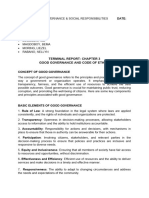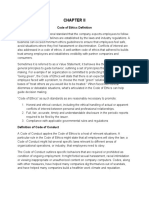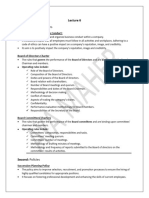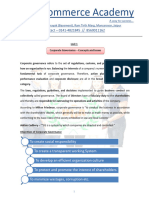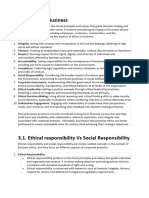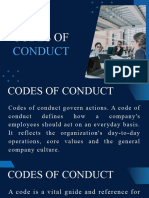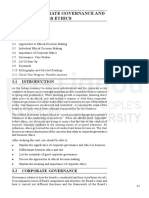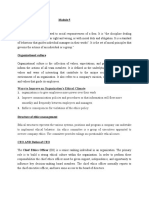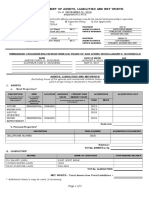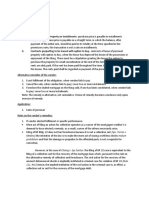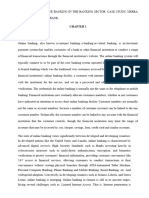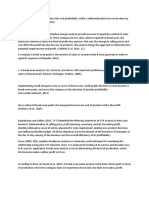Good Governance Reviewer
Good Governance Reviewer
Uploaded by
mananghayamonique053Copyright:
Available Formats
Good Governance Reviewer
Good Governance Reviewer
Uploaded by
mananghayamonique053Copyright
Available Formats
Share this document
Did you find this document useful?
Is this content inappropriate?
Copyright:
Available Formats
Good Governance Reviewer
Good Governance Reviewer
Uploaded by
mananghayamonique053Copyright:
Available Formats
Good governance Reviewer
MODULE 3
What is Corporate Governance?
Corporate governance has succeeded in attracting a good deal of public interest because of
its apparent importance for the economic health of corporations and society.
Philippine Securities and Exchange Commission (SEC), a principal player in corporate
governance matters, recently issued Memorandum Circular 2, Series of 2002, otherwise
known as the Code of Corporate Governance, under resolution no. 135, dated April 4, 2002
The Code applies to:
Corporations whose securities are registered or listed
Corporations that are grantees of permits/licenses and secondary
franchises from the Commission
Public companies
Branches or subsidiaries of foreign corporations operating in the Philippines whose
securities are registered or listed
Elements of Corporate Governance
Corporate governance is the role that company boards or executive teams play in
leadership and oversight. While the specific elements of corporate governance are many,
they generally emphasize creating and maintaining company direction and promoting
goodwill with shareholders and other stakeholders.
Good board practices
Appropriate control and processes
A stable regime of disclosure and transparency
Protection of (minority) shareowner rights
Strong commitment to corporate governance reforms
Agency Theory
Agency theory defines the relationship between the principals (shareholders of the company) and agents
(directors of the company). According to this theory, the company's principals hire agents to perform work.
Stewardship Theory
The steward theory states that a steward protects and maximizes shareholders' wealth through firm
performance. Stewards are company executives and managers working for the shareholders, protecting
and making profits.
Stakeholder Theory
Stakeholder theory incorporated the accountability of management to a broad range of
stakeholders. It states that managers in organizations have a network of relationships to
serve – this includes the suppliers, employees, and business partners. The theory focuses on
managerial decision-making and the interests of all stakeholders.
FACTORS INFLUENCING ETHICAL BEHAVIORS
Individual Factors
Many individual factors affect a person's ethical behavior at work, such as knowledge, values,
personal goals, morals, and personality.
Personal values (desirable behaviors and goals)
Values (the behaviors and things that we deem necessary in life)
Integrity (ability to adhere to a consistent set of moral principles or values)
Background and Experience (exposure to different environments)
Psychological Factors
Locus of Control: the extent to which a person believes they have control over the
events in their life.
Moral Imagination: the creativity with which one can reflect on an ethical dilemma
SITUATIONAL INFLUENCES
Organizational Context
Incentives: The systems of reward and punishment within the organization.
Authority: The exercise of hierarchical power to compel a subordinate to act in a certain way
Informal Organization Effects
Peer effects: Direct or indirect influence of others on one's behavior (due to
pressure or mere exposure)
Routines: Repeated patterns of behavior or interactions. Often mechanically
performed activities or procedures.
Organization Culture
Work roles: Functional and hierarchical
Bureaucracy: Suppresses morality by freeing the individual from moral reflection
and decision- making.
MODULE 4
I. Two (2) Distinct Approaches to Corporate Governance
Rules and principles are the two (2) general approaches to regulating corporate governance
practice. The United States and Sarbanes-Oxley is the only significant example of a rules-
based approach, with most countries preferring to regulate governance behavior by
observing general principles (Decker, 2018).
a. RULES-BASED APPROACH
(Adopted in the USA)
b. PRINCIPLE-BASED APPROACH
(Adopted in the UK)
Characteristics of Rules-Based Approach
a prescribed set of CG requirements
a quick way of ensuring compliance
adopts a checklist approach
a clear distinction between compliance and non-compliance
easy to see that an entity is complying
reduction of flexibility on the part of management and auditors
difficult to set rules to cover all situations
possible to misinterpret rules
same restrictions apply to all, whatever their size
Characteristics of the Principles-Based Approach
activities of entities must address major principles set out in codes of best practice
not merely a box-ticking exercise
more difficult to avoid than a rules-based approach
easy to see that the entity is complying
directors required to work in the entity's best interests
more flexible, and therefore better able to deal with new situations
more straightforward justification for an apparent breach of principles
principles may be interpreted differently
circumstances change
Development of Corporate Code of Conduct and Ethics
It contains information pertinent to the individual and their action on the job
but may collect detailed offshoot information from its ethics code. Many
companies require the employee to sign the code of conduct, which becomes a
legal agreement between the employer and the employee.
Sections of a comprehensive professional code of conduct include:
a. Company mission
b. Purpose of the code of conduct
c. Compliance with laws or laws relevant to employee or member rights
d. Outline of unacceptable behaviors in the workplace and their consequences
e. Outline of internal practices such as dress code, drug use, or sexual harassment
policies
f. Outline of external practices such as confidentiality and conflicts of interest
g. Company and equipment use and protections
h. Outline of code compliance expectations
i. Training requirements and guidelines
j. Job duties and employment benefits
k. Chain of command for disciplinary action
Purpose of a Code of Conduct
A code of conduct aims to develop and maintain a standard acceptable to the company, its
vendors, customers, and other employees. Although they will differ from industry to industry,
the conduct code includes behavior guidelines consistent with company policies and reflects
how the company perceives its image.
Disciplinary or Legal Tool
Since signed codes of conduct can be considered legal documents, they can be used as a disciplinary
or legal action tool for employee infractions.
Blanket or General Clauses
Blanket clauses state that the employee agrees to follow the rules published in an employee handbook
(which should include a dated signature document). You may further detail particular rules, regulations, and policies
in the manual.
Information to Include
Create a code of conduct with language that is as clear as possible
You might also like
- Prototype Formulation For Car Polish: AutomotiveDocument2 pagesPrototype Formulation For Car Polish: AutomotiveRoman100% (2)
- Lesson-3Document10 pagesLesson-3Efraim QueNo ratings yet
- Organistaion Climate, Dilemma Integrity PactDocument23 pagesOrganistaion Climate, Dilemma Integrity PactJagat Pal Singh GohilNo ratings yet
- Organization Structure & EThicsDocument17 pagesOrganization Structure & EThicsJagat Pal Singh GohilNo ratings yet
- GGSR Wk7Document24 pagesGGSR Wk7magalongjeremygleneNo ratings yet
- Advanced Auditing CH 5Document34 pagesAdvanced Auditing CH 5abel habtamuNo ratings yet
- CODE OF ETHICS AND PROFESSIONAL CONDUCT Day 5Document55 pagesCODE OF ETHICS AND PROFESSIONAL CONDUCT Day 5Monika ChandelNo ratings yet
- G3 Good Governance and Code of EthicsDocument8 pagesG3 Good Governance and Code of EthicsKim Diah Macagumban DiasemenNo ratings yet
- Corporate Governance and EthicsDocument28 pagesCorporate Governance and EthicsAndrea PalomeraNo ratings yet
- Difference Between COE & COCDocument3 pagesDifference Between COE & COCAshutosh RanjanNo ratings yet
- EthicsDocument8 pagesEthicssuper quotes newNo ratings yet
- Ethics Code: The General Value SystemDocument23 pagesEthics Code: The General Value Systeminflibnet inflibnetNo ratings yet
- Module 2 Crim 4Document13 pagesModule 2 Crim 4Emmanuel James BasNo ratings yet
- Business Ethics and Corporate GovernanceDocument23 pagesBusiness Ethics and Corporate GovernanceSanket NarkhedeNo ratings yet
- Cororate GovernanceDocument4 pagesCororate Governancew_sampathNo ratings yet
- Principles of Corporate GovernanceDocument6 pagesPrinciples of Corporate GovernanceTrần Ánh NgọcNo ratings yet
- Code of Ethics and Moral FrameworksDocument18 pagesCode of Ethics and Moral Frameworkskanwarpreet.e9570No ratings yet
- Math 12 ABM BESR Q1 Week 4Document14 pagesMath 12 ABM BESR Q1 Week 4AÑORA, Princess Aeyah M.No ratings yet
- Code of Business EthicsDocument5 pagesCode of Business EthicsShiela Velasco dela PeñaNo ratings yet
- Codes of Right ConductDocument10 pagesCodes of Right ConductShiena Jane BayleNo ratings yet
- Fundamentals of Management: Corporate GovernanceDocument15 pagesFundamentals of Management: Corporate GovernanceBalochNo ratings yet
- Module 6: Corporate Governance and Business Ethics 10 HoursDocument6 pagesModule 6: Corporate Governance and Business Ethics 10 HoursCVRNo ratings yet
- 04 Handout 1Document3 pages04 Handout 1Katelyn Mae SungcangNo ratings yet
- MIDTERM-LESSON-1Document13 pagesMIDTERM-LESSON-1johnben cabangNo ratings yet
- Ethics To IntroductionDocument49 pagesEthics To IntroductionavegalevalenciabebarNo ratings yet
- Unit-3 PeDocument14 pagesUnit-3 Perahulraj1152004No ratings yet
- Professional Conduct CHAPTER IIETHICALSTANDARDDocument112 pagesProfessional Conduct CHAPTER IIETHICALSTANDARDjoshuabron100% (2)
- Business Ethics ch17 PowerpointDocument50 pagesBusiness Ethics ch17 Powerpointndwalanethobeka3No ratings yet
- Lecture 66Document2 pagesLecture 66ayamaher3323No ratings yet
- Ethics-OJT Task 2Document3 pagesEthics-OJT Task 2John Lexter MacalberNo ratings yet
- business ethics projectDocument14 pagesbusiness ethics projectHarsh VermaNo ratings yet
- EGC - Module 3 - 240101 - 173445Document8 pagesEGC - Module 3 - 240101 - 173445abhishekknpy21No ratings yet
- CG 1Document4 pagesCG 1vikasbasantani84No ratings yet
- CORPORATE GOVERNANCE... PowerpointDocument81 pagesCORPORATE GOVERNANCE... PowerpointEng Tennyson Sigauke100% (2)
- Business Ethics (Unit 2)Document9 pagesBusiness Ethics (Unit 2)prabhav1822001No ratings yet
- Unit 3. Ethics and BusinessDocument10 pagesUnit 3. Ethics and Businessrasikasonawane31No ratings yet
- Chapter ThreeDocument10 pagesChapter ThreeAdurehim AbdulkerimNo ratings yet
- Module 3 - Crim 104 2022 2023Document9 pagesModule 3 - Crim 104 2022 2023Kent CaroNo ratings yet
- Corporate Governance-1Document10 pagesCorporate Governance-1Monirul IslamNo ratings yet
- Group2 CSRDocument44 pagesGroup2 CSRArellano Rhovic R.No ratings yet
- Why Code of ethics and differenceDocument4 pagesWhy Code of ethics and differenceAbdullah KhalidNo ratings yet
- Unit 3Document14 pagesUnit 3Light YagamiNo ratings yet
- 33a. Business EthicsDocument5 pages33a. Business EthicsNeema EzekielNo ratings yet
- Module 5 EthicsDocument10 pagesModule 5 EthicsGodzon Seban PullattNo ratings yet
- Codes of EthicsDocument5 pagesCodes of EthicsGodha KiranaNo ratings yet
- Corporate Governance - Amistad BautoDocument11 pagesCorporate Governance - Amistad BautoBoulton FamilyNo ratings yet
- All India Essay Writing Competition I CsiDocument4 pagesAll India Essay Writing Competition I CsiboraseobsamNo ratings yet
- Corporate Governance and Business EthicsDocument5 pagesCorporate Governance and Business Ethicsatulyash1No ratings yet
- GGSR - Chapter 6Document18 pagesGGSR - Chapter 6Steffanie OlivarNo ratings yet
- Lecture 5Document20 pagesLecture 5coeustradersNo ratings yet
- Rohit Satarke 2022EPGP042 LAB AssignmentDocument19 pagesRohit Satarke 2022EPGP042 LAB AssignmentRohitNo ratings yet
- Besr-Q1 W3Document30 pagesBesr-Q1 W3yuanaaerith13No ratings yet
- Module 7Document6 pagesModule 7tabarnerorene17No ratings yet
- Auditing and Assurance AssignmentDocument18 pagesAuditing and Assurance AssignmentJiya and Riddhi DugarNo ratings yet
- BFB 3451 - Corportae Governanace - UndergraduateDocument33 pagesBFB 3451 - Corportae Governanace - UndergraduateAnthonyNo ratings yet
- Business Ethics and MNCDocument21 pagesBusiness Ethics and MNCsanchitshah777100% (1)
- Ethical Issues in The Financial Services IndustryDocument23 pagesEthical Issues in The Financial Services IndustrySubodh Mayekar50% (2)
- Code of ConductDocument2 pagesCode of ConductFALAK NAZ MUHAMMAD HUSSAINNo ratings yet
- BE Jan-20Document15 pagesBE Jan-20Vatsal ChangoiwalaNo ratings yet
- Part 1 of Module I GBERMICDocument12 pagesPart 1 of Module I GBERMICjhie boterNo ratings yet
- "Reigning the Boardroom: A Trailblazing Guide to Corporate Governance Success": GoodMan, #1From Everand"Reigning the Boardroom: A Trailblazing Guide to Corporate Governance Success": GoodMan, #1No ratings yet
- Tutorial 1 QuestionDocument8 pagesTutorial 1 QuestionTyrah 01No ratings yet
- L6 NVQ COMP CCOM Iss3-2Document243 pagesL6 NVQ COMP CCOM Iss3-2marcadonislevyNo ratings yet
- Allan Tunis: Career OverviewDocument6 pagesAllan Tunis: Career Overviewashish ojhaNo ratings yet
- Waqas CV UpdatedDocument2 pagesWaqas CV Updatedshazalwaqas1No ratings yet
- Chila Saln 2019Document2 pagesChila Saln 2019Glorie Lyn Prevendido ZapantaNo ratings yet
- Revalidation of Registration and Licence To Practice GMC UKDocument41 pagesRevalidation of Registration and Licence To Practice GMC UKWee K WeiNo ratings yet
- Economics of Milk Production in Haveri DistrictDocument76 pagesEconomics of Milk Production in Haveri DistrictSoumen ChoudhuryNo ratings yet
- Philippine National Police Executive Summary 2021Document7 pagesPhilippine National Police Executive Summary 2021bluedragonfuryNo ratings yet
- Quizfebruary 27 SolutionsDocument2 pagesQuizfebruary 27 SolutionsSherstobitov SergeiNo ratings yet
- Unit 5 - Revision NotesDocument28 pagesUnit 5 - Revision Notesapi-679810879No ratings yet
- Submitted To: Ma M Nadia JamilDocument35 pagesSubmitted To: Ma M Nadia JamilsumimaryNo ratings yet
- AML KYC FormDocument4 pagesAML KYC FormGOWTHAM MSNNo ratings yet
- Traducción o Interpretación de Un Texto Académico en Inglés Del Área de PostgradoDocument8 pagesTraducción o Interpretación de Un Texto Académico en Inglés Del Área de PostgradoIPC Telecom100% (1)
- 0 ISO 17025 2017 TransDocument10 pages0 ISO 17025 2017 TransdanielmugaboNo ratings yet
- Recto and MacedaDocument3 pagesRecto and MacedaDeness Caoili-MarceloNo ratings yet
- SPACE Matrix: Internal Analysis: External AnalysisDocument3 pagesSPACE Matrix: Internal Analysis: External AnalysisMuhammad Faiez HazlyNo ratings yet
- Section 135 of Companies Act For Corporate Social Responsibility - TDocument3 pagesSection 135 of Companies Act For Corporate Social Responsibility - TVivek ANo ratings yet
- Communication Skills For Workplace SuccessDocument24 pagesCommunication Skills For Workplace SuccessEunice Adriana LazarNo ratings yet
- Indonesia Rooftop Solar - A Difficult Balancing ActDocument9 pagesIndonesia Rooftop Solar - A Difficult Balancing Actegaa.jonooNo ratings yet
- Respondant 2 (Adult)Document4 pagesRespondant 2 (Adult)Mir Insha Ur RehmanNo ratings yet
- CaseAnalysis 1 v1.0 - AmitDocument4 pagesCaseAnalysis 1 v1.0 - AmitAmit Mohan SaklaniNo ratings yet
- Materials ManagementDocument7 pagesMaterials ManagementKeshava NagalkarNo ratings yet
- Nayana Ex 8Document3 pagesNayana Ex 8Nayanashree NNo ratings yet
- Learnovate Task No. - 03Document4 pagesLearnovate Task No. - 03Nikita Daki80% (5)
- Applied Economics: Chapter 1-2-3Document20 pagesApplied Economics: Chapter 1-2-3cristianaNo ratings yet
- UntitledDocument30 pagesUntitledAhmad GilaniNo ratings yet
- Chapter 1Document16 pagesChapter 1Emmanuel BongayNo ratings yet
- ScratchDocument5 pagesScratchERIKA JANE BOLIMANo ratings yet
- Intellectual Property Rights and Computer Technology: Ethical and Social... J.M.KizzaDocument24 pagesIntellectual Property Rights and Computer Technology: Ethical and Social... J.M.KizzaTolosa TafeseNo ratings yet







